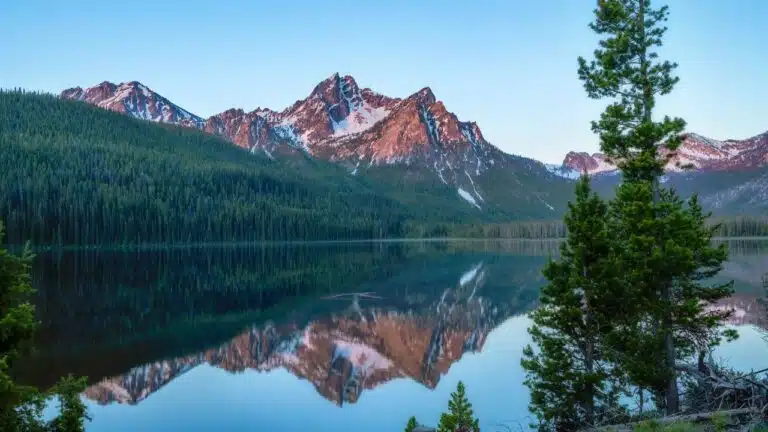The Azores are best summed up as a little slice of Europe nestled within a tropical paradise. Quaint towns and colorful cities draw you in with their charming churches, winding streets, and enchanting views, but it’s out in nature where you’ll truly fall in love. The natural landscapes of the Azores are breathtaking in their beauty and infinite in number, ranging from sparkling lagoons and cascading waterfalls to steaming hot springs and volcanic vents that tunnel deep into the earth. In short, the Azores are a nature lover’s escape. So, if you’re ready to fall into paradise, here are 33 stunning places in the Azores you can’t miss.
This post may contain affiliate links. Making a purchase through our site may earn us a commission at no additional cost to you. This does not affect the independence or quality of our content.
Table of Contents
São Miguel
Sete Cidades

If you’ve seen a picture of the Azores, you’ve likely seen a picture of the Sete Cidades. These two lagoons, Lagoa Verde and Lagoa Azul, are the most iconic attraction on all the islands, with glistening waters surrounded by lush vegetation and beautiful blooming hydrangeas. With the mountains rising up in the background, it’s not hard to understand its visual appeal. Sete Cidades constitutes one of the most beautiful spots on the Azores. Such beauty is best appreciated from multiple angles and at different times of day. And those interested can do just that, driving up to epic viewpoints like Miradouro Vista do Rei, hiking to breathtaking panoramas like Miradouro da Boca do Inferno, or stopping by striking vistas like Miradouro do Cerrado das Freiras, for a spectacular horizontal view of the lakes and the road that separates them.
Lagoa do Fogo

Formed 15,000 years ago, Lagoa do Fogo is the island’s youngest caldeira. The name translates to Lagoon of Fire, which, given the crater’s volatile volcanic eruptions in the past, seems rather apt. Rest assured, the only thing volatile about this place now is the weather; fog rolls in and out pretty frequently. But once it clears, this spot shines. The lagoon is surrounded by incredible beauty, with sloping hills and beautiful woodlands. Whether you opt to take the long hike to see all the nature and beauty on display or pop in to the miradouros for a quick look and some spectacular photos, this is one spot in the Azores you can’t miss out on.
Salto do Cabrito

Hiking through the Azores always promises something magical, and Salto do Cabrito doesn’t disappoint. Half the beauty of this destination lies in the journey: a hike through lush forests, over flower-covered bridges, and past picturesque stone houses to arrive at an incredible waterfall hidden among the dense vegetation. Nestled between jagged cliffs dotted with leaves and patches of moss, the waterfall plunges over 130 feet into the pool below. On warm days, it’s an irresistible spot to take a break and cool off, or you can continue to see the view from the top and really soak in the scenery.
Furnas

Furnas is called the Valley of Hot Springs, and a visit here will quickly reveal why. The entire area is basically one giant, dormant volcano that you can see, smell, feel, and even taste. Admire the views from Lake Furnas, take a dip in soothing hot springs, savor Portuguese dishes cooked in fumaroles, and sip on volcanic purple tea. From bubbling mud springs and spewing geysers to steaming fumaroles and relaxing mineral baths—Furnas is a hotbed of geothermal activity and a veritable playground for all things natural and unique. So forget making this a quick stop; Furnas is a destination you’ll want to enjoy for days.
Salto do Prego

They say it’s not about the destination; it’s the journey that counts. Visiting Salto do Prego feels like that, with the journey being half the fun. The Sanguinho Loop Trail whisks travelers down forested trails, past lovely countryside views, and even on side quests to other waterfalls. (For those with the time, a quick pit stop by Salto do Cagarrão is a must.) And at the end of this journey lies the spectacular treat at the heart of it all: Salto do Prego. Tucked away in a canyon blanketed by moss and ferns, Salto do Prego is a natural beauty. Fed by cold, crystal-clear waters, the base of the waterfall is the perfect scenic spot for a dip or a picnic. And on the way back, you can’t miss a walk through the enchanting, timeless village of Sanguinho. This is arguably one of the most popular hikes on São Miguel.
Poça da Dona Beija

Furnas has a lot of treats, but this is one treat that really treats you. Called the Pool of Youth, Poça da Dona Beija might not actually make you young, but these iron-rich waters can improve your health in other ways, from reducing pain and increasing blood circulation to improving skin conditions and helping reduce allergies. Tucked among lush jungle scenery, they’re a serene place to relax and soak in the beauty of the Furnas Valley. And best of all, you can even enjoy the baths at night under the stars! It’s a magical experience you’re unlikely to forget anytime soon.
Ribeira dos Caldeirões Natural Park

Beautiful? Absolutely. Exciting? You Bet. A must-stop on the Azores? You better believe it. From the moment visitors arrive at the park, they’re greeted by the most popular attraction: the Bride’s Veil waterfall. But just because you can see this beauty from your car doesn’t mean you should make this a quick pit stop and continue on your way. Bride’s Veil is far from the only beauty in this park; you can find picturesque falls all over. Hunt down the five 16th-century watermills located in the park and even see some of them in action! And we can’t forget the biggest draw, aside from the scenery—canyoning in the park. For the fearless adventurers looking for something to do in the Azores that will feed their wild side, leaping in ponds, rappelling down waterfalls, and slipping between canyons will certainly scratch that itch.
Ponta Delgada

Ponta Delgada is the enchanting capital of the Azores archipelago. What began as a tiny fishing village in the 15th century has changed very little over the last few centuries. But that’s not to say there isn’t anything to discover here. Visit the city square to see the Portas da Cidade, the three arched city gates, and Igreja Matriz de São Sebastião, the 15th-century Gothic church that stands nearby. One can spend hours walking the narrow cobblestone streets and hilly landscapes of Ponta Delgada, popping into markets, sitting down at cafes and restaurants, and exploring the churches that dot the city. Ponta Delgada is also a great spot to head out and do some whale-watching and dolphin-watching in the right season. Or head in the opposite direction, uphill, to Ermida de Nossa Senhora Mãe de Deus to admire the views from above.
Mosteiros Beach

With so many gems in São Miguel’s interior, it’s almost easy to forget one of the highlights of this island: its coastline. São Miguel boasts over a dozen beaches, each one unique and beautiful. But there’s something about Mosteiros Beach; it’s not the biggest or the busiest, but it might just be the boldest in terms of scenery. Like others on the island, Mosteiros Beach is a volcanic black sand beach. The deep black of the sand contrasts with the blue water and verdant greenery of São Miguel, making this one of the most picturesque beaches on the island. But its bold beauty doesn’t stop there. Mosteiros Beach is the perfect spot to watch the sunset paint the sky in fantastic colors and silhouette the islets offshore. Even better, you can watch it all from Sunset Steve’s Bar while nibbling on bifanas and toasting the epic sunset.
Lagoa do Congro

They say nothing worth having comes easy, and in the case of Lagoa do Congro, that’s a fact. This lagoon is a beautiful hidden gem that, despite people knowing about it, is still considered hidden because it lies off the well-beaten tourist paths. So if you want to see this beauty, you’ll have to go out of your way to do it. But the reward is certainly worth the effort. Once you arrive at Lagoa do Congro, you’ll be immersed in a lush cacophony of color, from the verdant trees to the shimmering emerald lake. While other lakes on São Miguel are elevated, Lagoa do Congo sits in a hole at the bottom of a crater, truly immersing you in this green fairytale world.
Porto Formoso Tea Plantations

One of only two commercial tea plantations in Europe (yes, you read that right), the Porto Formoso Tea Plantation provides a glimpse into the island’s tea-making history, making it both a plantation and a museum. Although much smaller than its neighboring tea plantation, the Gorreana Tea Factory, Porto Formoso offers a less crowded and more intimate experience. Visitors can take a tour of the grounds, sample different tea varieties, and every year, in the spring, participate in a traditional tea-picking recreation complete with old-fashioned attire. Snap photos among the tea fields, sit on the veranda and admire the views of the sea, and if you have time, stop by the neighboring plantation to check out the scenic 3-mile hike around the grounds.
Miradouro de Santa Iria

São Miguel boasts its share of stunning miradouros overlooking jaw-droppingly beautiful views, and no matter how many you see, they never get old. Perched on a hill overlooking the north coast, Miradouro de Santa Iria lays claim to sweeping views of the island’s rugged coastline and the majestic Atlantic Ocean. The viewpoint sits 725 feet above sea level, allowing visitors to see a vast expanse of São Miguel stretching into the distance, from the parishes of Porto Formoso and Maia to the Ponta do Cintrão Lighthouse, all the way in the distance. To make this miradouro even more unique, you’re likely to spot animals on the grounds, including horses, which add a bit of extra magic to your photos here. Best of all, it’s easily accessible by car; no hiking required.
Nossa Senhora da Paz
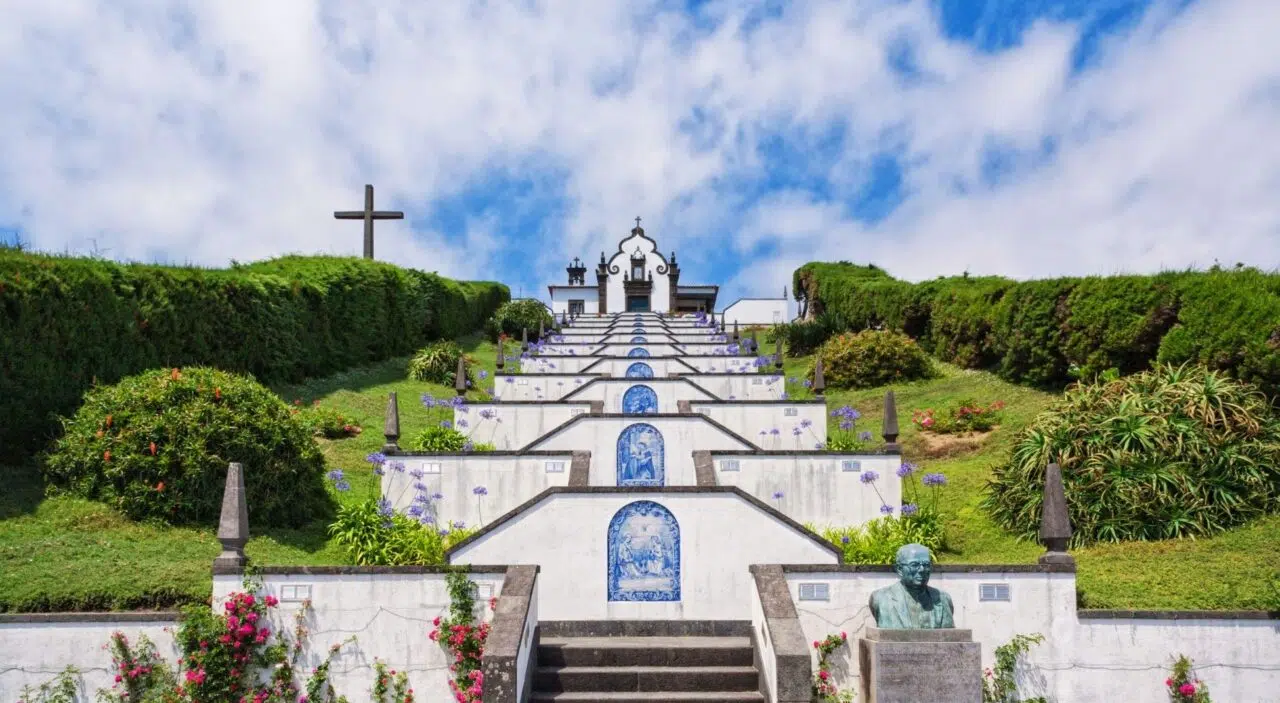
Every year, thousands of visitors flock to this little chapel in Vila Franca do Campo, and for good reason. While the Azores’ natural pools, cascading waterfalls, and verdant landscapes shine, the islands also boast their fair share of gorgeous man-made beauties. The Nossa Senhora da Paz is one such building, and one of the most breathtaking examples of Azorean architecture on the island. The chapel sits atop a steep hill overlooking the town, sea, and countryside. After admiring the church and taking a few pics from the bottom, take a shot at scaling the 100 steps and ten landings for a view that’s truly out of this world!
Islote de Vila Franca

If you visit Nossa Senhora da Paz first, you’ll likely have spotted this little islet off the coast. Rising out of the Atlantic Ocean, the Islote de Vila Franca forms a perfect circle, hence its name, the Princess Ring. Inside this one-of-a-kind lagoon, visitors will find a peaceful pool with crystal clear water and colorful fish darting about. Part of a small, underwater volcano, the islet provides safe, tranquil waters for swimming and serves as a home to various bird species that nest there. Whether you experience it as part of a whale-watching tour or spend a few hours enjoying the beautiful underwater scenery, Islote de Vila Franca is a little slice of paradise you won’t soon forget.
Terra Nostra

In the heart of São Miguel, tucked away within the Furnas Valley, lies a centuries-old botanical garden, Terra Nostra. Conceived in 1775, what first began as a residence and small garden has evolved into a sprawling park encompassing gardens, forests, and even a thermal pool. The geothermal activity in the area creates peak conditions for a wide variety of fauna to flourish. Consequently, it’s the perfect green retreat, with a lush setting that’s perfect for relaxing in paradise or exploring the grounds. Stroll down the romantic Ginkgo Avenue, pay a visit to Lovers’ Fountain, explore the magical grottoes, and walk along the mesmerizing Serpentine Canal. Of course, no visit to Terra Nostra would be complete without taking a dip in the thermal pool for a rejuvenating soak. This garden promises to sweep you off your feet and into enchantment.
Lagoa Pau Pique
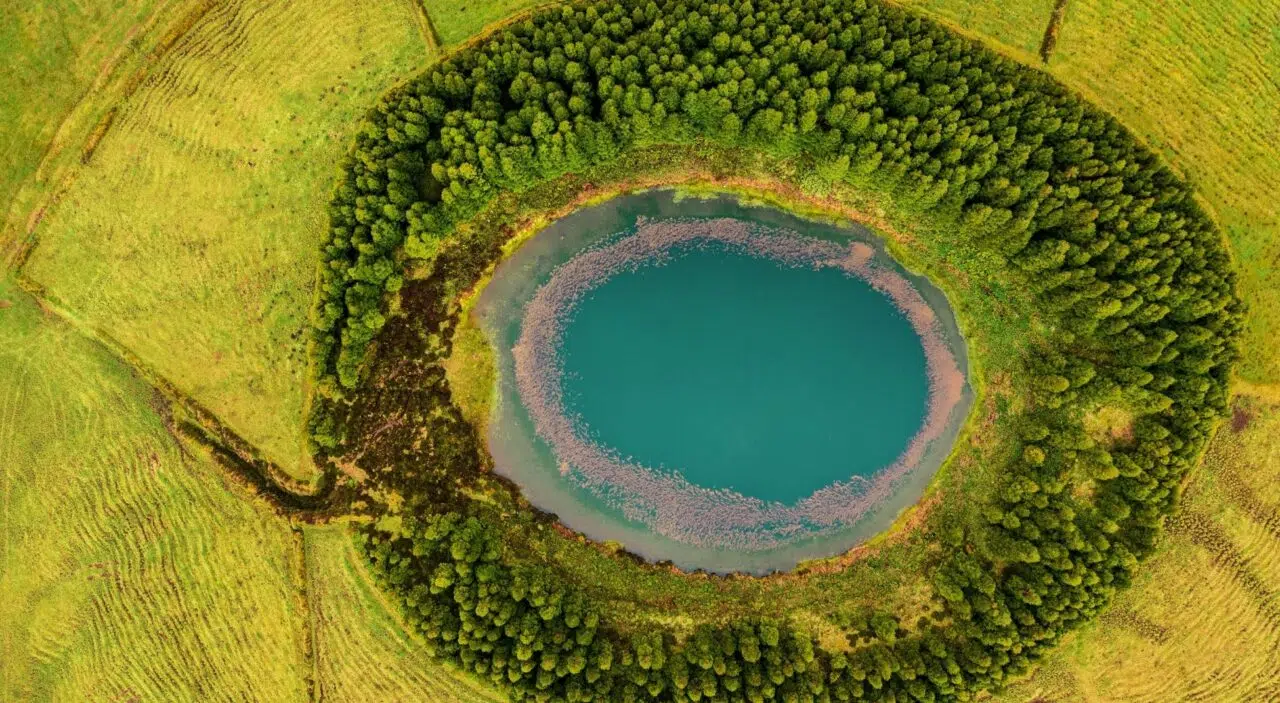
If you’re looking for a hidden hideaway on the Azores, one where you won’t run into scores of tourist crowds, then this spot’s for you. Lagoa Pau Pique is a crater lake situated atop a hill, with no paths leading to it and concealed within a copse of trees. When the fog hangs low, it pretty much disappears! Before you enter the copse of trees, you can walk around it for views of the surrounding countryside, made up of rolling hills and verdant greenery. But once you enter the trees, you’re spirited away to a world of wonder, where you can bask in nature and the quiet without the click of a camera or the shouts of other people—totally at peace.
Capela de Nossa Senhora das Vitórias
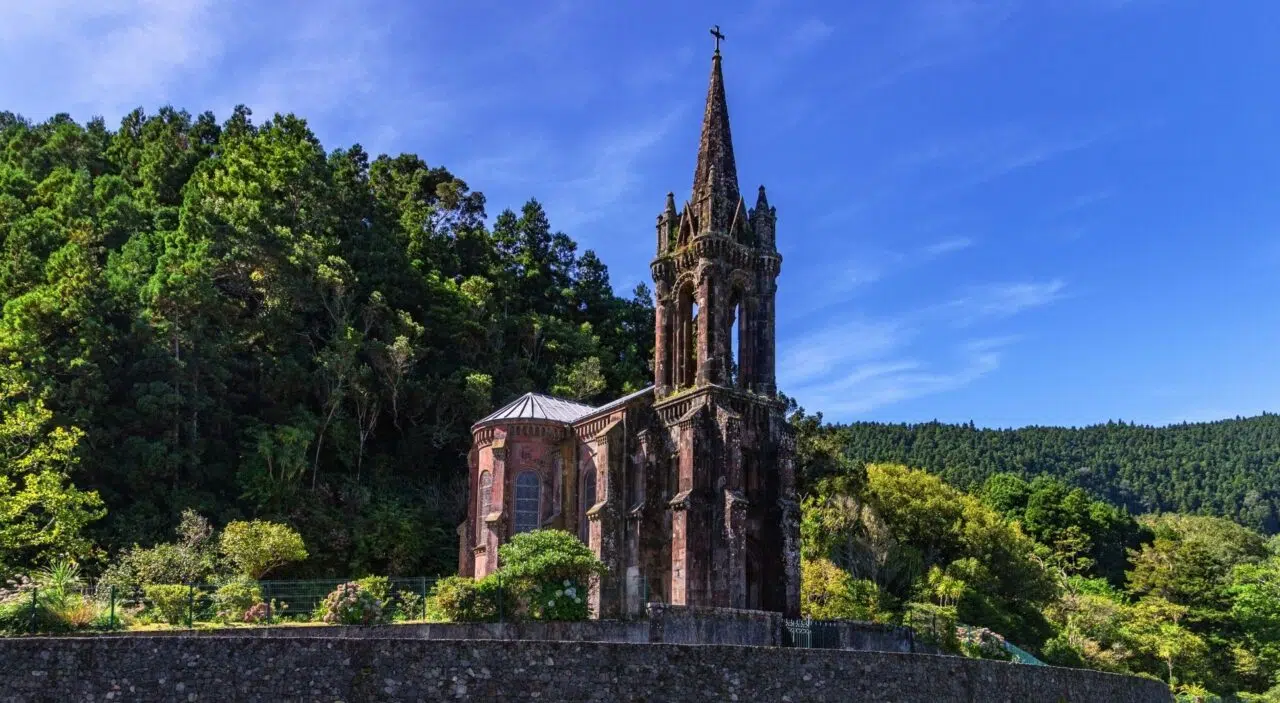
You won’t find much that’s classically European on this island, but with gems like Capela de Nossa Senhora das Vitórias, you don’t need very many. This Christian chapel, built in the neo-Gothic style, is the only one of its kind on the island, and there’s a reason for that. The chapel was commissioned by José do Canto as a symbol of devotion to his sick wife, with whom he was later buried in the church. As for the chapel itself, it appears like an enchanted daydream rising up out of the lush greenery in the background. Surrounded by Lake Furnas, the chapel gardens, and the distant mountains, the Capela de Nossa Senhora das Vitórias paints one of the most picturesque scenes in all of the Azores. And whether you’re deeply religious or just in love with love, you can’t miss exploring this unique treasure.
Caldeira Velha

Looking for a more “natural” experience of the Azores’ thermal hot springs? Then try visiting the Caldeira Velha hot springs. Located up in the mountains, you’ll know you’re headed in the right direction when you see steam coming up from the side of the road. At the Caldeira Velha, visitors will find three pools ensconced in a lush jungle canopy, complete with requisite frog noises (100% real by the way). If you just want to explore the park, it’s free to visit, or you can pay to spend 90 minutes in the thermal pools. And you can’t leave without paying a visit to the waterfall on the grounds. Though significantly cooler than the hot springs, the beauty of the falls and the green canopy create an ideal setting for a refreshing dip.
Arnel Lighthouse

In operation since November 1876, Arnel Lighthouse is the oldest lighthouse on the Azores and a postcard icon of São Miguel. Located on the east side of the island, the lighthouse overlooks the sprawling expanse of the ocean, a poignant reminder of just why lighthouses are needed when staring into the infinity of the sea stretching into the distance. The lighthouse has two main viewpoints. The Ponta do Arnel Viewpoint provides the closest view of the lighthouse, accompanied by a breathtaking panorama over Vila do Nordeste and the Atlantic Ocean. Vista dos Barcos Viewpoint offers a unique view of the lighthouse and São Miguel Island, making them both worthwhile stops if you find yourself exploring this area of the island.
Terceira
Angra do Heroísmo
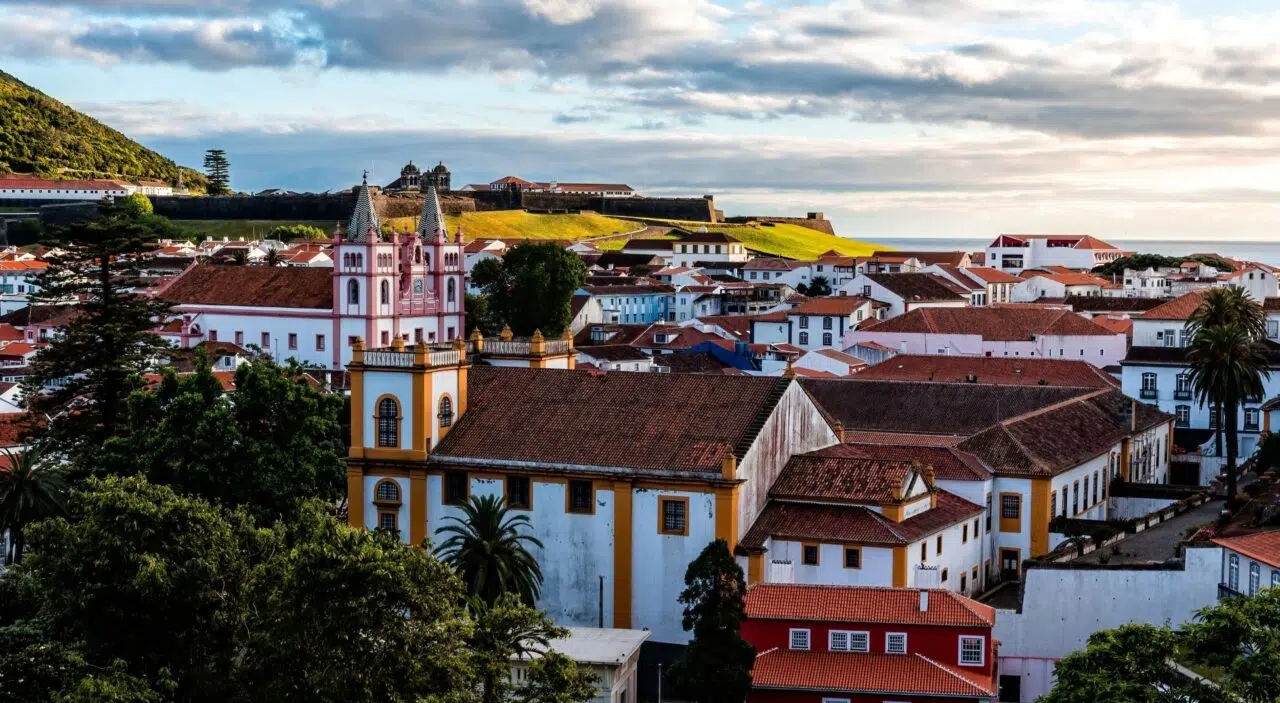
One of the most beautiful cities on the Azores Islands actually had to be rebuilt after an earthquake destroyed its historic center in 1980. Rather than taking it as a sign to develop with the times, Angra do Heroísmo lovingly reforged itself in its original design, preserving the city’s history and culture. Exploring the city feels like walking through time. The cobblestone streets, colorful houses, and historical buildings, such as the Cathedral of Angra do Heroísmo and the Fortress of São João Baptista, put into perspective the city’s brave soul and creative spirit, highlighting what makes it feel so special. Whether you spend your time indulging your sweet tooth, hiking Mount Brasil, or basking in the views of the bay, Angra do Heroísmo will leave its mark and stay with you long after you leave.
Miradouro Serra do Cume
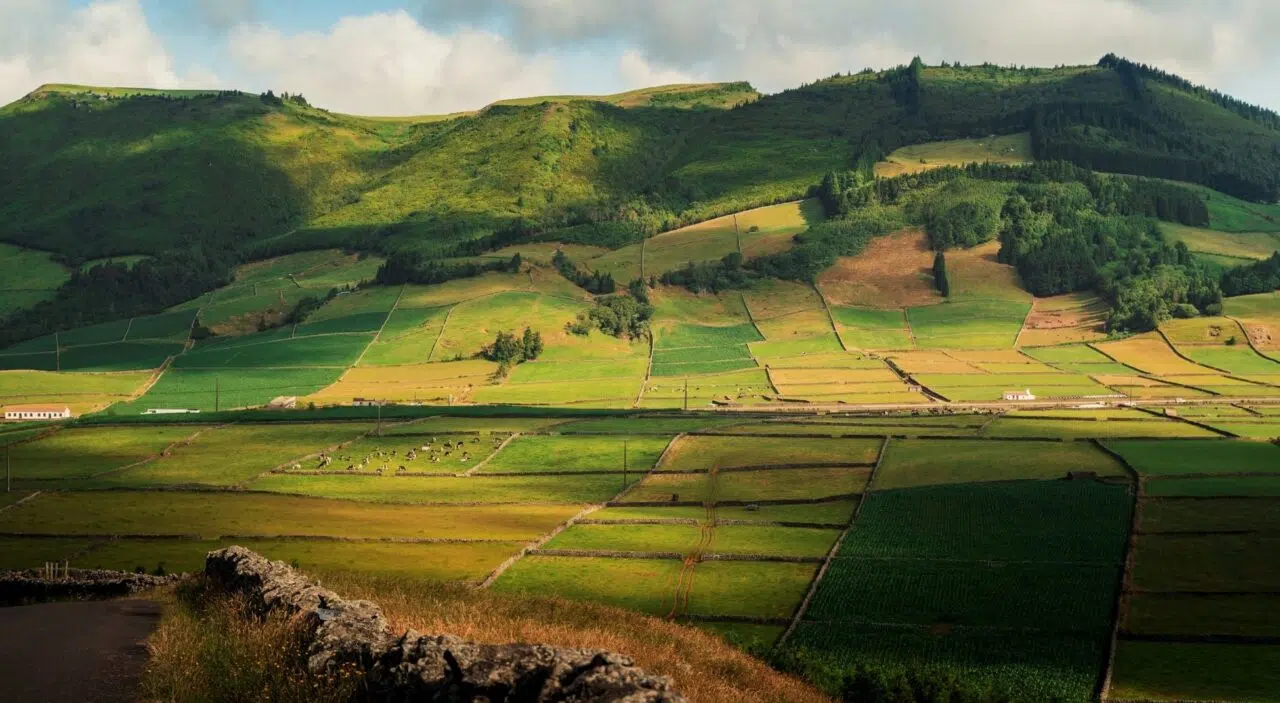
The Azores boast plenty of beautiful views, but some are so iconic and picturesque, you’d be doing yourself a disservice by missing out on them. And with that in mind, it’s only right that one of your top five things to do on the island of Terceira in the Azores is to visit the Miradouro Serra do Cume to see the patchwork green pastures sprawling across the island. The lookout itself is a result of a volcanic eruption. In 2008, a wooden bridge was constructed to allow visitors to gaze out over the southeastern part of the island, which is largely dominated by the patchwork landscape. The patchworks themselves are another natural element. Separated by lava rock walls and rows of hydrangeas, the patchworks have become a quintessential highlight of the island’s natural beauty.
Biscoitos Natural Pools
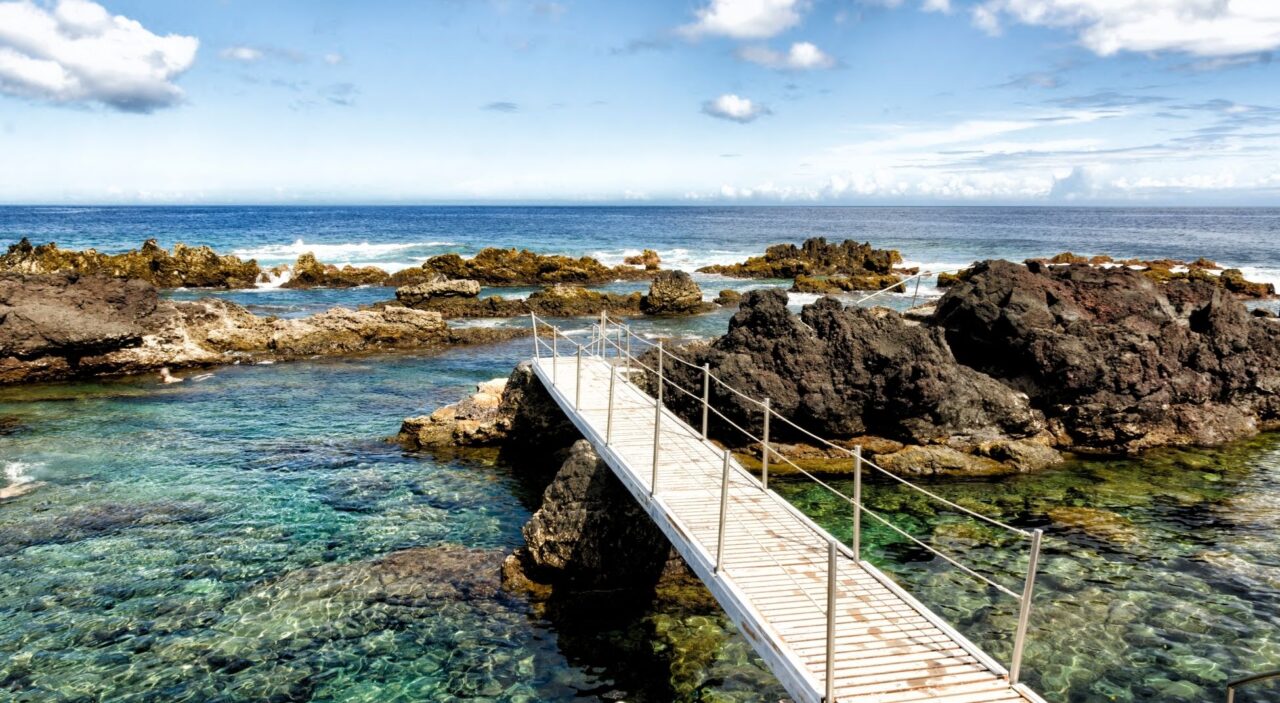
Between the hot springs, waterfalls, and thermal baths, the Azores doesn’t disappoint for relaxing and beautiful escapes. But while most others are buried in the lush jungle or set amid countryside scenery, the Biscoitos Natural Pools sit smack dab in the ocean. Formed by rocky outcroppings left behind by a volcanic eruption, these natural pools sit out in the open sea, creating a naturally beautiful and popular bathing area. It’s both relaxing and thrilling to sit back within the ocean waters while the dramatic waves beyond the rocks kick up ocean spray and create little mini waterfalls over the black volcanic rock. Add in the spectacular scenery, and it’s all more than enough to make this a must-see stop amid your Azores exploration.
Algar do Carvão

The Algar do Carvão is a unique spot on Terceira Island, for the simple fact that this beauty lies not on the island’s surface, but below it. This ancient, volcanic vent tunnels underground, ending nearly 300 feet below, just above a dazzling lagoon with astounding geological formations. It’s one of the few volcanic vents in the world that you can head directly down the throat of, and not only that, but emerge in a beautiful underworld, one covered in vibrant moss, lush ferns, and glittering stalactites. For those visiting Terceira, it’s a once-in-a-lifetime experience to venture into the depths of the earth through the mouth of an ancient volcano.
Ilhéus das Cabras
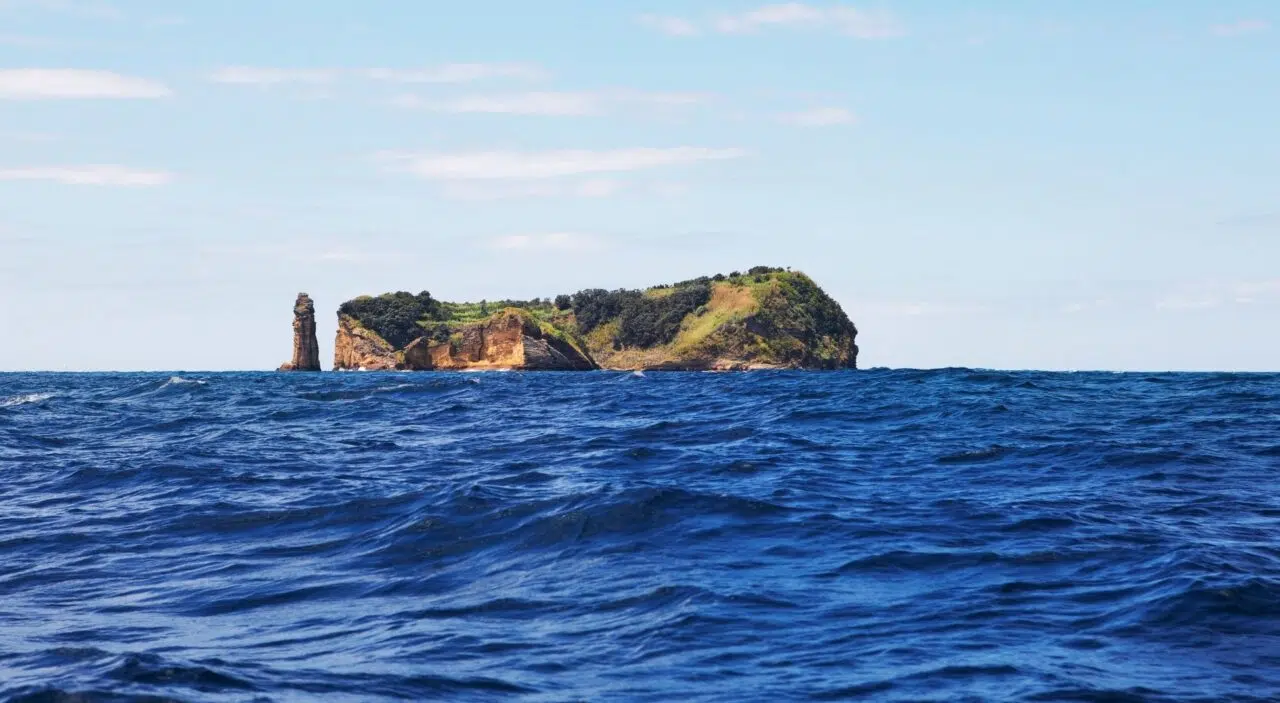
Underwater volcanoes created the two islets known as Ilhéus das Cabras that sit off the coast of Feteira near Angra do Heroísmo. The two islets, the largest in the Azores archipelago, create a magnificent silhouette that’s impossible to ignore; it’s no surprise that most people don’t. Boat tours, the only way to visit these landforms, flock to and around the islets, whisking past sparkling seabeds, rocky reefs, and beautiful coastlines to arrive at the towering islets. There, you can see the slightly submerged Eagle’s Ray Cave and Cathedral’s Cave. Bird lovers will enjoy watching the cliffs to see what’s hiding among the rocks. And in the background, the impressive landscape of Terceira Island itself makes for the perfect photo op. The Azores are a constant reminder of how much beauty there is in nature, and the Ilhéus das Cabras are another stunning feature to put on your Azores to-do list.
Flores
Poço da Ribeira do Ferreiro
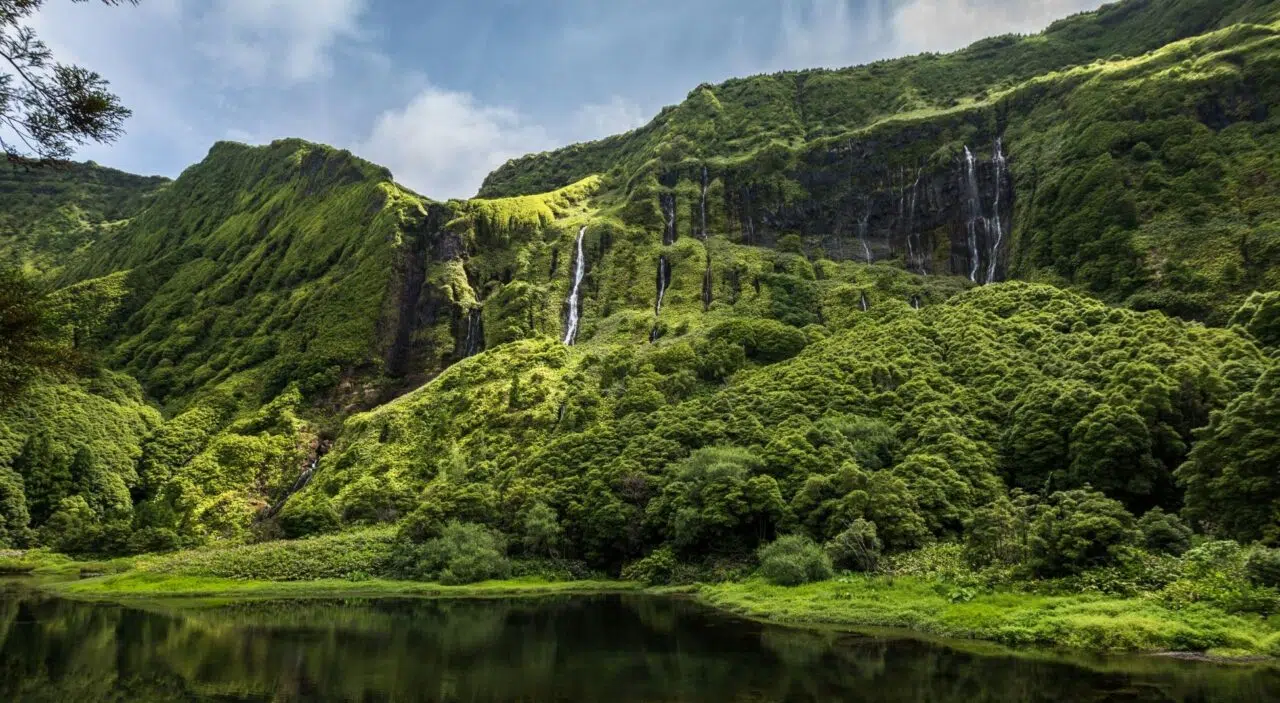
Just when you think you’ve seen enough waterfalls, you stumble upon a place that steals your heart and your breath. Poço da Ribeira do Ferreiro looks like it was put together with a little movie magic à la CGI. But this Flores gem is one hundred percent real, though every bit as otherworldly as you’d imagine. Waterfalls stream down the high cliff face like trails of silver tears. The lake at its base reflects the image of the cliff face back from the ground, creating a dreamy mirage over the rippling water. And lush greenery and vibrant moss add a touch of whimsy. Perhaps best of all, the spot sits at the end of a 20-minute hike, adding a curtain of calm quiet to allow visitors to soak in the enchanting beauty. Don’t be surprised if you find yourself coming back more than once to get your fill.
Poço Do Bacalhau

If the Poço da Ribeira do Ferreiro is a soft enchantment, then the Poço Do Bacalhau is a loud crowd-puller. At nearly 300 feet tall, Poço Do Bacalhau cuts an impressive figure, even from a distance. During the rainy season, it comes down in a heavy surge. But during the hot summer months, it trickles to a thin stream, cascading down the giant cliff face and into a cool, crystal clear pool below. It should be no surprise that the pool is a popular bathing spot for both locals and tourists. Whether you opt for a relaxing dip in the waters, a heart-pumping canyoning adventure, or challenge yourself with a hike along the Poço do Bacalhau Hiking Trail, one thing is for sure, and it’s that you have to experience this waterfall for yourself.
Twin Crater Lakes

With the Twin Crater Lakes, you get two great spots for the price of making it to one. Caldeira Comprida and Caldeira Negra sit side by side. And based on the names, you may think you know which is which, but this is a similar switcheroo to Iceland being green and Greenland being covered in ice. Caldeira Negra is the green lake and the larger one. It’s also the deepest crater lake in the Azores, which is why it’s also called Caldeira Funda. In contrast, Caldeira Comprida is the black lake, though it’s surrounded by plenty of greenery, and even a scenic waterfall that’s all but hidden from most angles.
Pico
Pico Mountain

This island’s defining feature is also its favorite attraction. At 7,713 feet tall, Pico Mountain stands out from the surrounding landscape in a big way; it’s even visible from nearby Faial and São Jorge. While far from the tallest mountain in the world, it’s certainly the tallest in the Azores, making it the ultimate challenge for anyone visiting Pico. With its steep incline and ever-changing weather, it’s not something to undertake lightly. But the reward is a hike full of magic, from a landscape that’s very much alive right beneath your feet to a magical view out over the Azores that will take your breath away—what’s left after the climb anyway.
Moinho Do Frade / Paisagem da Cultura da Vinha da Ilha do Pico
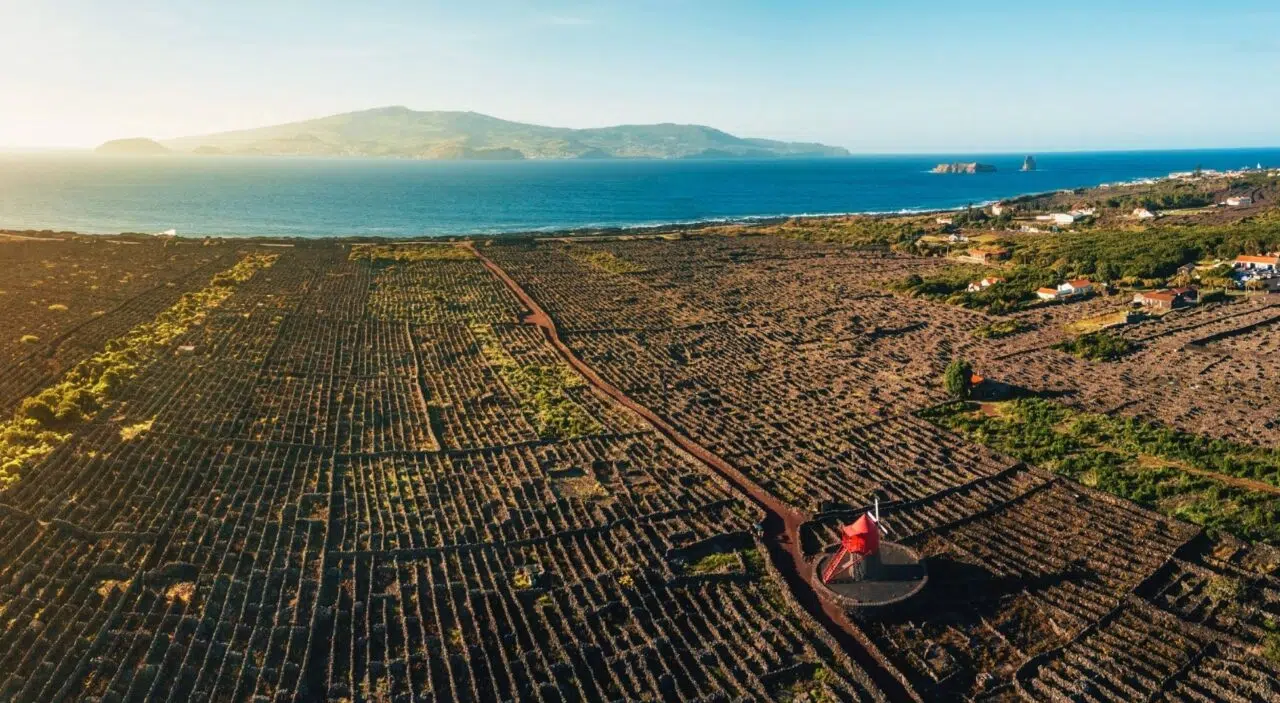
In contrast to Pico Mountain, Moinho Do Frade is remarkably easy to get to, making it a must-visit for anyone in the area. This charming traditional windmill sits within the Paisagem da Cultura da Vinha, or the Landscape of the Pico Island Vineyard Culture, a beautifully crafted landscape that combines natural elements with volcanic rock. Pico boasts a wealth of viniculture to explore, and this site is just one small taste. But this spot offers decades and even centuries of tradition to explore and admire, whether you’re soaking in the panoramic views from the red-topped Moinho Do Frade, marveling at the carefully constructed rows of the basalt stone vineyard, or sipping on the world-famous wine that once graced the lips of kings.
Faial
Horta

Horta is a sea city that sucks you in from the moment you arrive in port and never lets you go. Despite its size, Horta feels leagues away from a small town. A good dose of travelers from all over gives the city a cosmopolitan energy that you can feel from the beautiful bay to the buzzing cafes. Check out the mural and art-covered walls of the Marina, pop into the sailor’s bar Peter’s Cafe Sport for a taste of Azores history and some island gin, and explore the pretty promenade along Horta’s waterfront. From the charming harbor to the epic viewpoints, Horta captivates, whether you’re knee-deep in its streets or viewing it all from above.
Porto Pim Beach

Just a hop and a skip away from Horta lies one of Faial’s most visited sites, Porto Pim Beach. Fine sand and perpetually warm, crystal clear waters make this the most visited beach on the island because it can be enjoyed all year round. But it’s not just its accessibility that makes Porto Pim popular; it’s its beauty. Backed by the stunning Monte da Guia and surrounded by volcanic dunes and lush green hills, the beach is one of the most visually stunning shores on the island. And with plenty of restaurants, sun beds, and even umbrellas for rent, it’s the perfect place to spend a few hours or the whole day soaking up the sun and sea.
Capelinhos Volcano

Capelinhos Volcano is a veritable showstopper. Formed from the last recorded eruption in the Azores, the craggy cliffs and black landscape are a stark and eye-catching contrast to the rest of the Azores’ lush greenery. That singular beauty is a large part of what makes this attraction so popular. Not only is it a spot to revel in the majesty of nature, but it’s a great place to explore some of Faial’s history, from walking the Whale Trail, which highlights the past importance of whaling to the island’s economy, to the Capelinhos Volcano Interpretation Center, which transports visitors back in time to September 27, 1957, the date that Capelinhos Volcano erupted into the Atlantic Ocean. And don’t forget a stop at the Capelinhos Lighthouse, a perfect place to look back and marvel at the volcano or look forward and admire a spectacular sunset.
Caldeira do Faial

Faial’s crowning landmark, the Caldeira do Faial, is a perfectly circular caldeira located in the heart of the island. Over 1,300 feet deep and more than a mile in diameter, it’s a breathtaking natural monument—a giant pit covered in green vegetation and even sporting a lagoon at the base. Bursting with trees, flowers, and a wide diaspora of plants, the Caldeira do Faial looks like a glimpse into another world, certainly one untouched by man. Whether you simply admire it from above, journey around its perimeter, or make the descent down into its interior, you’re guaranteed an otherworldly experience that will feel like nothing else on the Azores.

